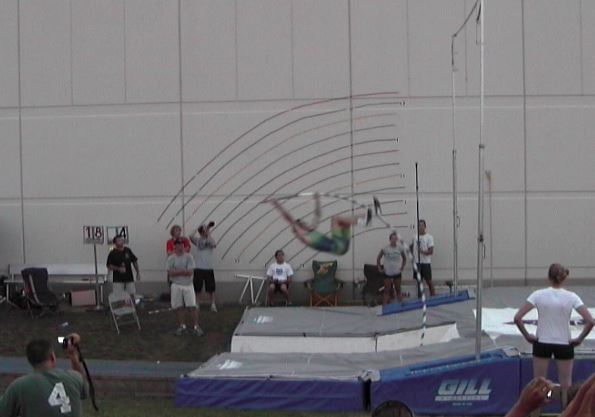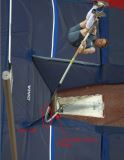try again
“what effect does the circular rotation of the pole”
“how can you not see the effect that the centripetal force of the poles rotation”
PVDaddy – I ask you to show me the circular motion – educate me – show me a sequence of photos or figures that show the pole (pole COM since that is where this force would be based upon) rotating in a counterclockwise (right handed vaulter) direction – not moving to the side and ending in the corner of the back of the box and the left side wall. The COM of the pole has to rotate in a circular motion about some point on the poles chord or vaulters attachment to impart the centripetal force you are alluding to.
Since the mass of the pole is very small relative to the system it would have less of an affect (pole would be in the 2kg to 2.5kg range) - it would be about the velocity (squared) as it travels this “circular” path – again you say it is traveling a circular path –
Everything needs reference points:
Centerline of runway is x axis
Vertical point from middle of the back of box (going straight up) is the y axis
Back of box horizontal perpendicular to the x axis is the z axis:
The vaulters COM travels primarily in the xy plane, this is if the vaulter that lands straight in the pit on the x axis. We are not looking at what variations cause a deviation from this.
Since the COM of the pole and the radius ( we are talking centripetal force and for it to be circular by definition this distance r (radius) would need to be constant) about which the pole COM is traveling relative to the point the centripetal force is applied – we need to examine if this really happens.
Lets assume the pole COM is at the midpoint of the pole (usually at some point below this) – when the vaulter initially takes off it is moving forward in the xy plane – the force has to be applied at the top hand or some point in the handgrip region depending on bottom hand interaction– but that is not the critical point for this example – just the general location. The pole COM will move towards the YZ plane in an upward sloping path and as the pole “turns” to the side the COM will move in the Z direction. Max bend - see photo below

- JeffHartwig560xx72%.jpg (29.51 KiB) Viewed 43359 times
It is clear that the COM of the pole is closer to the YZ plane than the vaulters attachment to the pole and this is point the radius of the circular path would be based upon. At this point in the vault the pole typically ends up in the left corner of the box (see photo) – at this point the pole COM is moving back towards the xy plane in a slightly upward path (pole is unbending) – the vaulters attachment point (center of the radius if there were a circular movement) is moving up (y) at a steeper rate and slightly forward in the x direction.

- Hooker pole COM3.jpg (4.38 KiB) Viewed 43359 times
So you even mention in you "L" example the fact it is changing -- now the pole COM is moving upward throughout the vault - moves in the XY plan at the start then has some positive z axis movement (positive being to right) as the pole is unbending it is moving back towards the XY plane or a direction change.
So where in the vault is there this circular motion that imparts this centripetal force --
Video can be deceiving since it is rarely at correct angle -- USA Track and Field actually had Peter McGinnis doing some videoing and study with various axis of recording so they could accurately record the vault -- there is a reason for the chord lines on the building and camera location showing the max bend -- so does 3:19 show the pole turning as I described above - the circle motion required for the centripetal force you speak off - the radius is changing, the direction changes, the relative displacement of the COM to the point it is to act upon changes --
I will agree that I do not see it the same way you do --




